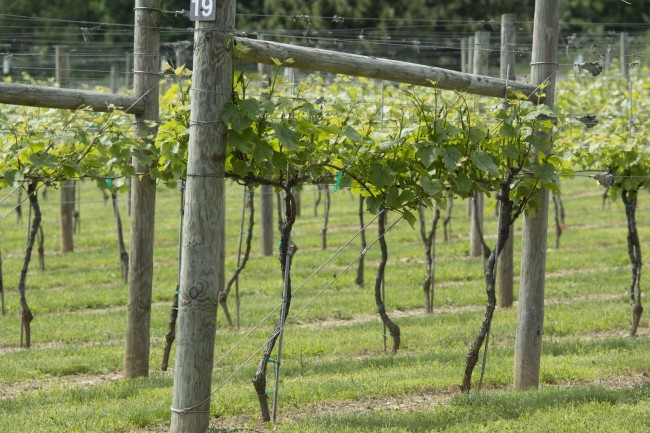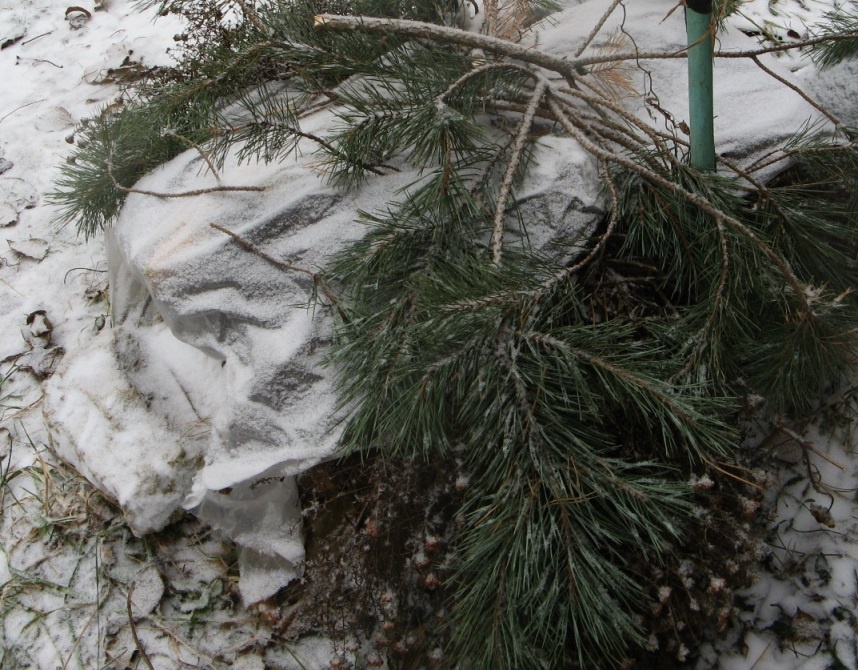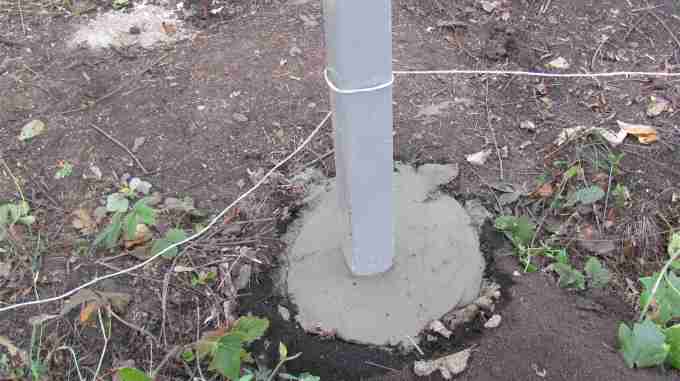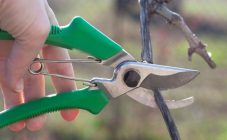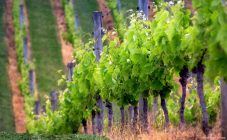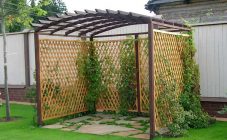Content:
Grapes are a unique plant that belongs to fruit vines. It is successfully grown even in the middle lane, some technical and table varieties are grown in the Moscow region on an industrial scale. However, grapes are a wayward culture that requires favorable conditions for growing and fruiting. He needs a place to grow, enough sunlight, water and, of course, a trellis for grapes. The grape frame prevents the vine from sagging and performs a whole list of necessary functions. It is worth figuring out what types of structures are and how to build a vineyard with your own hands.
What is the support for grapes
Grapes by nature are liana. The life form of a plant that uses tree trunks and branches from other crops to create a support to occupy more illuminated areas. In the vineyards or in the courtyard of the cottage, you can build supports for the grapes.
- The grape net forms the correct skeletal basis of the culture during its development, and also maintains the optimal shape of the bush after years.
- Thanks to the grape grate, the shoots are evenly spaced, therefore, they do not shade each other, the plant is provided with a sufficient amount of sunlight.
- Metal, wood or plastic structures, due to the correct shape, greatly simplify the care of grapes.
- Thanks to the profile structures, the likelihood of developing fungal diseases is significantly reduced, this is due to the fact that the foliage is removed from the soil, there is good air circulation.
How to make a support for grapes
Grape trellis are classified according to various characteristics. By the principle of application, they are divided into:
- Single-plane - formed by the frame and consist of one work plane.
- Two-plane - have two single-plane frames, but are connected to each other.
- Frames that are made according to individual plans.
Single-plane trellis
Visually, the design is simple, consists of two or more supports, and they are connected by wire. As the vines grow and develop, they twine around the wire, and a new plane gradually forms. It is this form of construction that is more common, due to its compact arrangement and cheap materials. You can build them from scrap materials.
Before proceeding with the construction of a single-plane trellis, it is necessary to determine the tasks that the structure will cope with. The main advantages of the structure:
- The products are budget-friendly, they do not require a lot of building materials to manufacture them, there are enough available tools.
- Almost all parts of the grape bush are provided with sunlight and air. No shadow will be generated by the second plane of the frame.
- The vine can be approached from any side, so it will be easy for the grower to prune and irrigate the crop.
- In winter, it is easier to cover grapes located on a single-plane trellis.
- The erected structures are quite compact, so any garden crops can be grown between them on the ground.
Despite the large number of advantages, such supports also have disadvantages. First of all, such structures are not suitable for heavy plants. Some grape varieties grow very strongly and there is simply not enough room for them to grow in one plane. In this case, the culture will greatly thicken and it will not be possible to harvest a decent harvest, and the likelihood of the development of various fungal, infectious and viral diseases will also increase.
It should be added that there is no opportunity to collect the maximum amount of the crop, since the formation of a large bush is impossible due to the rather limited area of the structure.
Two-plane trellis
There is a wide variety of two-plane tapestries. The most common:
- V-shaped. The two parts of the structures are connected at the very surface of the soil; they expand upward.
- Parallel. The two planes are mounted parallel to each other.
- Y-shaped. Visually, this type of structures resembles V-shaped ones. Their difference lies in the fact that one plane emanates from the soil, and diverges from the ground at a certain height.
Complex shapes are made according to individual drawings.
Thanks to the multiple planes, the vines grow in a comfortable environment. The bunches manage to hide from sunlight and piercing gusts of wind. Among specialists, Y-shaped structures are most common.
The vines are properly ventilated, and some grape varieties are able to provide an abundant increase in yield. These instructions are recommended for non-covering grape varieties. Design advantages:
- The grower has the ability to grow more powerful bushes, while preventing thickening of the shoots. Each plane is capable of supporting about 3-4 sleeves.
- It is possible to plant more bushes in a limited area.
- Thanks to good ventilation and the absence of shading, it is possible to harvest large grapes from each bush.
- Such designs improve pollination conditions.
- The bunches have the ability to hang freely, which reduces the likelihood of sunburn and wind damage.
- In such conditions, it is much easier for the wine grower to comply with all agrotechnical rules, as well as to irrigate the bushes with special preparations that are designed to prevent the development of diseases and attacks of insect pests.
Despite the large number of advantages, do not forget about the disadvantages. The most significant among them:
- To produce such structures, you will need twice as much building materials, and they are also quite difficult to install (especially V-shaped and Y-shaped trellises).
- Two-plane trellis have a significant drawback - the gardener does not have the opportunity to get to certain areas, this complicates the process of plant care and treatment.
- The process of sheltering grapes for the winter becomes more complicated, sometimes it is necessary to dismantle an entire part of the structure in order to open access to the vine, which must be sheltered from winter frosts.
If there is a need to cover the grapes for the winter, it is better to use the tunnel method. To do this, a roofing material or a protective plastic film is thrown through the lower wire, forming protective niches.
If you use boxes or slate for shelter, the pillars must first be displaced relative to the base of the vine by 0.4 meters. It will be easier to cover the plants in this way, and the root system will also be less affected.
DIY constructions
Do-it-yourself metal trellis for grapes is quite simple to build, the main thing is to stock up on tools, building materials and patience.
First of all, you need to correctly determine the location of the future vineyard:
- The grapes should be planted in the sunniest part of the summer cottage.
- Trellis should always be located from north to south.
Instructions for making a fence for grapes:
Before proceeding with concreting, the pillars must be properly prepared. The pipes should be painted with weatherproof paint. The part of the pipe that will be located underground must be painted in several layers. The ground-to-air crossing section must be tarred.
Now you can start preparing the recesses for the posts. Their depth should be at least 0.7 meters, the diameter should be equal to three diameters of the pipe used. The indentations are prepared using a hand brace or a shovel. At the bottom, evenly distribute fine gravel or sand, pour plenty of water and tamp.
In order for the pillars to be installed evenly and not to mow, they must be installed in tandem with someone. The pillar is lowered to the bottom of the recess in an upright position, lined with broken brick or stones.
Then you can fill the column with cement mortar (1 bucket of Mark 500 cement and 3 buckets of sand). As the pit is poured, the cement mortar must be carefully tamped. After installation, it is necessary to give time to the solution to stand; at rest, the pillars should stand for at least one week.
The next item is the installation of stiffeners. It is important that they do not fold under the weight of a grape bush during operation. The optimal fasteners are metal corners (triangles), which are welded to the top of the posts.
A wire is pulled over the trellis for the vines. On the post, markings are made at intervals of 0.4 meters, and holes with a diameter of approximately 5 mm are drilled. Wire is pulled through all the holes in the pillars and fixed on the extreme pillars. For this, special clamps are implemented in specialized sales departments.
The wire must be well taut, otherwise it will sag under the weight of the bushes. For these purposes, tensioners are used; they can be bought in specialized stores or made by hand.
It is not so difficult to build frames for grapes with your own hands. If everything is done correctly, the constructed structures will serve for many years. There are many types of different structures, each of them has its own advantages and disadvantages, before proceeding with the installation, it is imperative to set the tasks with which they must cope.
